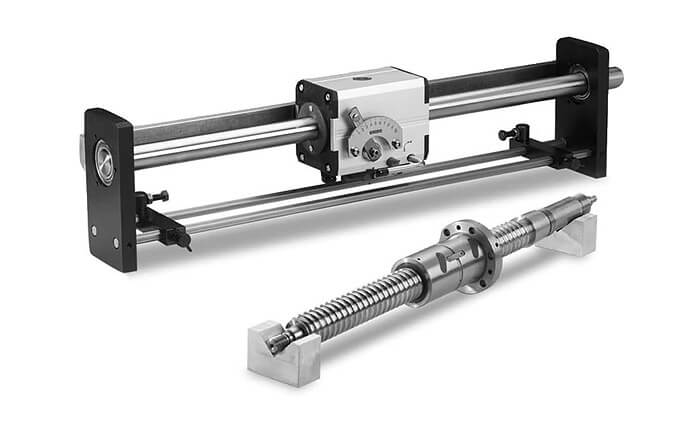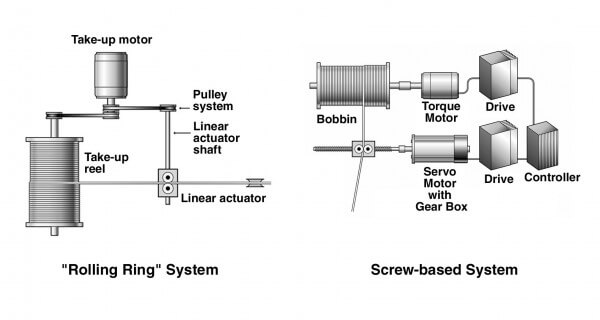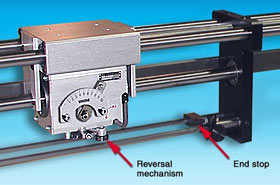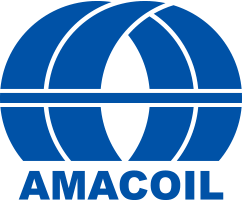How Reciprocating Motion Works in Industrial Production Machinery
Production machinery designed to provide reciprocating motion requires an integrated linear drive assembly to move the tool head back and forth. Reciprocating motion applications include: Painting, grinding, slitting, scanning, winding, scoring, spraying – basically any task where back-and-forth motion of a tool, camera, cutting blade or other device is needed.
When referring to reciprocating motion, engineers typically mean repetitive, back-and-forth motion over a fixed distance. An example is in a winding machine. A reciprocating linear drive is used to guide the wire, or other material being spooled, back and forth as it is being spooled. Reciprocating motion may also involve stops and starts, and varying stroke lengths. Although this is more often referred to as indexing or positioning.

Reciprocating linear drives utilize a broad range of technologies. The traditional, go-to set of reciprocating motion drive systems include screws, hydraulic systems, timing belt drives, pneumatic assemblies and others. These devices all have significant and complex maintenance requirements, and most often demand operator technical training.
Traditional reciprocating motion systems like those mentioned above can create unwanted downtime resulting from routine maintenance tasks. Tasks such as changing gears, replacing bent piston rods, replacing leaky seals and other repairs and maintenance procedures. Additionally, in high end reciprocating motion systems involving sensors and programming, repairs may require the services of electronics and PLC experts.
Automating reciprocating motion in machinery almost invariably requires multi-speed, direct-braked reversible motors; sensors; valves and solenoids; gear head assemblies; PLCs and other useful and innovative devices. Whether you design, operate or maintain this type of machinery, you’re probably familiar with these components. Designing-in various types of reciprocating linear drive assemblies is routine for the designer. And customers buying the machine generally accept the costs of training operators and maintenance technicians as part of the overall investment.
But a routine approach to reciprocating motion systems can make machine design needlessly expensive and complex. It also drives up operating and maintenance costs. Take an automated spray painting process, for example. A machine designer could develop a sophisticated electronic control system to provide the reciprocating motion of moving the spray head back and forth. After time and money are spent on system design and components, electronic controls typically necessitate further investment in the form of operator training. When the required reciprocating motion is basic, such as in a simple spraying system, seeking alternative methods for reciprocating motion can make machine design simpler and less costly.
A rolling ring reciprocating linear drive is one such alternative. Rolling ring drives are mechanical solutions for reciprocating motion. The Amacoil/Uhing reciprocating linear motion drive provides automatically reciprocating linear motion control without the complex controls, components and programming. Amacoil/Uhing reciprocating linear motion is backlash-free, and the only maintenance needed is periodic light lubrication of the drive shaft.

If a screw is used in a reciprocating motion system, care must be taken to prevent direct and debris from collecting in the screw threads. Otherwise, should something clog the screw threads, the system will churn and grind which can damage expensive system components. A bellows assembly is often used to protect threads.
In a rolling ring reciprocating drive, there are no threads. The shaft is smooth so dirt and debris cannot become trapped. That means no clogging or jamming – and no need to stop the system to clean the shaft. Reciprocating motion systems normally utilize clutches, cams and gears to control reversal of the drive head. Additionally, the drive motor may need to be slowed down or stopped before travel direction of the drive head can be reversed.

In an Amacoil/Uhing reciprocating motion system, automatic instantaneous reversal of the drive head is mechanically controlled independent of the drive motor speed and rotational direction. This eliminates the need clutches, cams or gears. There is no programming, nor do you need costly motors and controllers. Sensors and proximity switches are not required. Travel direction is controlled by adjustable end stops.
Reciprocating motion is simplified with a rolling ring drive system. To provide reciprocating motion, an Amacoil/Uhing rolling ring unit works on basic engineering technology that has bee in use for more than 70 years. Rolling ring bearings are specially machined so that when the shaft rotates, compression and friction of the bearings against the shaft convert rotary input motion into backlash-free linear output. The user-adjustable angle of the bearing assembly, relative to the shaft, is used to control the drive head’s linear pitch and travel direction. It’s all done completely without complex electronic controls.
Don’t accept the “normal” downtime and extra costs associated with operating and maintaining the reciprocating motion systems in production machinery. Amacoil rolling ring linear drive assemblies enable mechanical control over the tool head travel speed and direction independently of the motor. This simplifies machine design and reduces operating and maintenance costs.
